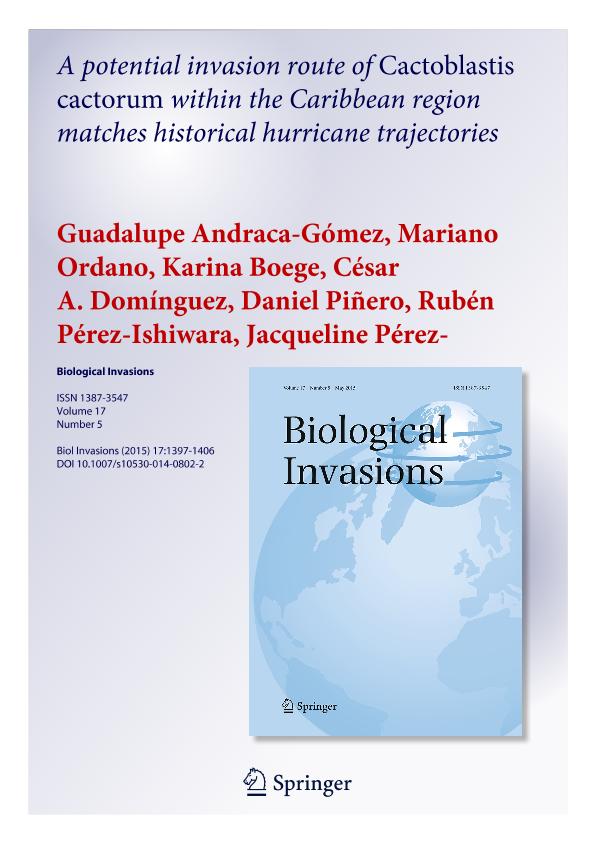Mostrar el registro sencillo del ítem
dc.contributor.author
Andraca Gómez, Guadalupe
dc.contributor.author
Ordano, Mariano Andrés

dc.contributor.author
Boege, Karina
dc.contributor.author
Domínguez, César A.
dc.contributor.author
Piñero, Daniel
dc.contributor.author
Pérez Ishiwara, Rubén
dc.contributor.author
Pérez Camacho, Jacqueline
dc.contributor.author
Cañizares, Maikel
dc.contributor.author
Fornoni, Juan
dc.date.available
2017-02-08T21:23:21Z
dc.date.issued
2015-05
dc.identifier.citation
Andraca Gómez, Guadalupe; Ordano, Mariano Andrés; Boege, Karina; Domínguez, César A.; Piñero, Daniel; et al.; A potential invasion route of Cactoblastis cactorum within the Caribbean region matches historical hurricane trajectories; Springer; Biological Invasions; 17; 5; 5-2015; 1397-1406
dc.identifier.issn
1387-3547
dc.identifier.uri
http://hdl.handle.net/11336/12758
dc.description.abstract
The cactus moth, Cactoblastis cactorum mainly distributed throughout central and northeastern Argentina was intentionally introduced in the Caribbean region in 1957 as a biological control agent of cacti species of the genus Opuntia. This moth invaded during the last 20–30 years the North American continent, threatening the major center of biodiversity of native Opuntia species. Although human induced and natural dispersal have been invocated to explain its expansion in the non-native distribution range, there is still no evidence to support natural dispersal. In particular, hurricanes are one of the major environmental factors affecting species dispersal in the region. In this study we used mitochondrial DNA to examine whether the spatial distribution of haplotype variation of C. cactorum is at least partially explained by hurricane trajectories within the Caribbean region. DNA sequences for the mitochondrial gene cytochrome oxidase I were obtained for a sample of 110 individuals from the Antillean islands. This information was combined with existing sequences in the GenBank for the same gene for the Caribbean and Florida (N = 132 sequences). Genetic diversity descriptors, a haplotypic network, a spatial analyses of molecular variance and a landscape genetic analysis of migration conditioned by hurricane tracks were conducted to test our hypothesis. Our results revealed a significant spatial grouping of haplotypes consistent with the more frequent hurricane trajectories in the Caribbean region. Significant isolation by distance conditioned by hurricane tracks was detected. Populations of Florida were genetically closer to those of Cuba than to the rest of the population sampled. Within the region, Cuba appears as a reservoir of genetic diversity increasing the risk of invasion to Mexico and the US. Despite commercial transportation of Opuntia promoted dispersal to Florida, our results support the hypothesis that natural disturbances such as hurricanes played a role dispersing this invasive insect. Future conservation programs of North American Opuntia species requires taking into account hurricane mediated dispersal events and permanent whole regional monitoring and international control policies to prevent future range expansions of C. cactorum.
dc.format
application/pdf
dc.language.iso
eng
dc.publisher
Springer

dc.rights
info:eu-repo/semantics/openAccess
dc.rights.uri
https://creativecommons.org/licenses/by-nc-sa/2.5/ar/
dc.subject
Cytochrome Oxidase I
dc.subject
Biological Invasions
dc.subject
Cactus Moth
dc.subject
Cactoblastis Cactorum
dc.subject
Dispersal
dc.subject
Phylogeography
dc.subject.classification
Ecología

dc.subject.classification
Ciencias Biológicas

dc.subject.classification
CIENCIAS NATURALES Y EXACTAS

dc.subject.classification
Otras Ciencias Agrícolas

dc.subject.classification
Otras Ciencias Agrícolas

dc.subject.classification
CIENCIAS AGRÍCOLAS

dc.title
A potential invasion route of Cactoblastis cactorum within the Caribbean region matches historical hurricane trajectories
dc.type
info:eu-repo/semantics/article
dc.type
info:ar-repo/semantics/artículo
dc.type
info:eu-repo/semantics/publishedVersion
dc.date.updated
2017-02-07T17:47:58Z
dc.identifier.eissn
1573-1464
dc.journal.volume
17
dc.journal.number
5
dc.journal.pagination
1397-1406
dc.journal.pais
Suiza

dc.description.fil
Fil: Andraca Gómez, Guadalupe. Universidad Nacional Autónoma de México; México
dc.description.fil
Fil: Ordano, Mariano Andrés. Fundación Miguel Lillo; Argentina. Consejo Nacional de Investigaciones Científicas y Técnicas; Argentina
dc.description.fil
Fil: Boege, Karina. Universidad Nacional Autónoma de México; México
dc.description.fil
Fil: Domínguez, César A.. Universidad Nacional Autónoma de México; México
dc.description.fil
Fil: Piñero, Daniel. Universidad Nacional Autónoma de México; México
dc.description.fil
Fil: Pérez Ishiwara, Rubén. Universidad Nacional Autónoma de México; México
dc.description.fil
Fil: Pérez Camacho, Jacqueline. Ministerio de Ciencia, Tecnología y Medio Ambiente. Instituto de Ecología y Sistemática; Cuba
dc.description.fil
Fil: Cañizares, Maikel. Ministerio de Ciencia, Tecnología y Medio Ambiente. Instituto de Ecología y Sistemática; Cuba
dc.description.fil
Fil: Fornoni, Juan. Universidad Nacional Autónoma de México; México
dc.journal.title
Biological Invasions

dc.relation.alternativeid
info:eu-repo/semantics/altIdentifier/doi/http://dx.doi.org/10.1007/s10530-014-0802-2
dc.relation.alternativeid
info:eu-repo/semantics/altIdentifier/url/http://link.springer.com/article/10.1007%2Fs10530-014-0802-2
Archivos asociados
